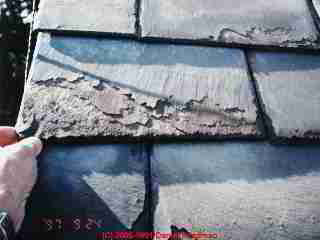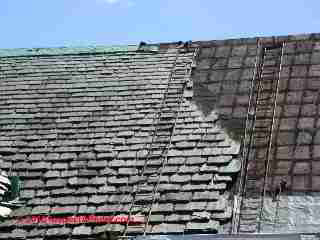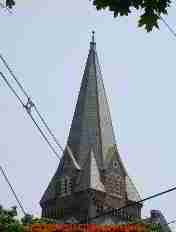 Slate Roofing Guide: how to inspect, troubleshoot, & repair slate roofs
Slate Roofing Guide: how to inspect, troubleshoot, & repair slate roofs
- POST a QUESTION or COMMENT about slate roof troubleshooting, leak diagnosis, & repair
Slate roof inspection, diagnosis & repair guide:
This series of detailed slate roof inspection and repair articles describes procedures for evaluating the condition of slate roofing. How to inspect, identify defects, and estimate remaining life of slate roofs are addressed.
This slate roofing article series also references slate repair procedures, repair slate sources, slate tool sources, and slate quarries around the world.
InspectAPedia tolerates no conflicts of interest. We have no relationship with advertisers, products, or services discussed at this website.
- Daniel Friedman, Publisher/Editor/Author - See WHO ARE WE?
A Detailed Guide to Slate Roof Inspection, Diagnosis, Installation & Repair
 Find here: A detailed guide to slate roof inspection, leak diagnosis, repair methods, and slate sources. How to inspect, evaluate the condition of slate roofs - how much slate roof life is remaining, and when is a slate roof beyond economical repair. Standards, specifications & methods for installing, inspecting, repairing slate roofs.
Find here: A detailed guide to slate roof inspection, leak diagnosis, repair methods, and slate sources. How to inspect, evaluate the condition of slate roofs - how much slate roof life is remaining, and when is a slate roof beyond economical repair. Standards, specifications & methods for installing, inspecting, repairing slate roofs.
A guide to the types, colors, and durability of different types of roofing slates. A guide to slate roof installation and flashing. Where to buy slate for roofs, where to buy slate roofing tools.
Slate roofing is considered a high-quality, durable, and aesthetically pleasing material which receives considerable focus in both the sale of properties and in the evaluation of building condition.
Our photo (left) shows a slate roof being replaced in Duluth Minnesota.
[Click to enlarge any image]
Like many building topics, opinions run heavier than actual data. The abandonment of good slate roofs which should have been repaired is a financial shame and the destruction of a valued asset.
At the
same time, careless optimism about a bad slate roof which is at the
end of its life risks an angry inspection client. This article reviews
types of slate, common defects, inspection topics, and some repair
tips. We also provide slate sources and where to buy slate roofing materials and slate roofing tools and products.
Watch out: before walking on a slate roof,
see ROOF INSPECTION SAFETY & LIMITS
A Very Short History of Slate Roofs & The Composition of Slate
 According to the US NPS "Roofing for Historic buildings" article series:
According to the US NPS "Roofing for Historic buildings" article series:
Slate is a fine grained crystalline rock metamorphosed from bedded deposits of clay and silt. It can be worked into shingles readily because it has two lines of breakability: cleavage and grain. These occur generally at right angles to each other and are independent of the original bedding planes.
[See SLATE COLORS, Chemistry for details.]
A specification for one of the designs included this direction for the French roof: "Slate the sides of the roof with slate 5 x 12 inches, nailed with galvanized nails; all hips and valleys to be flashed with tin in the best manner." the bedding remains in some slate deposits as visible bands running across the cleavage.
Known as ribbons, these bands may be either weaker or harder than the surrounding slate. Slate's durability as roofing is due to its high strength, low porosity and low absorption rate. Specific mineral components are responsible for the various colors: carbon (black), hematite (red and purple), chlorite and ferrous iron oxide (green).
[see RIBBON SLATES]
Other minerals, considered impurities (calcite and iron sulfides), are slowly transformed by weathering into gypsum, which expands and causes the slate to delaminate.
Slate has been used as a roofing material in Europe for hundreds of years [we believe for more like a thousand or so, or for millenia if stone slabs are included - Ed.], with surviving examples dating to the 8th century.
From the 17th to the 19th centuries, most of the roofing slate used in America was imported from North Wales, where slate quarrying was a major industry.
Although the first commercial slate quarry in the United States was opened in 1785 in Peach Bottom, Pennsylvania, the industry was limited and local until the second half of the 19th century.
At that time the industry grew and matured in response to a growing population, advancements in quarrying technology, an expanding rail system, and the immigration of Welsh slate workers to America.
The United States became a slate exporter after the Civil War, as quarries opened in Vermont, New York, Virginia, and Pennsylvania.
Architectural styles of this period emphasized prominent roof lines and decorative patterns, details that were well suited to the varied colors and shapes available in slate. Properties such as nonflammability, durability, minimal maintenance costs, and aesthetic value made slate all the more desirable. Its primary drawback was its weight, making shipping costly and requiring substantial roof framing.
Between 1897 and 1914 production peaked. Later use of slate often employed different thicknesses and colors, and unevenly cut or aligned butts to produce picturesque effects suitable for English revival styles popular in the early 20th century.
After 1915 widespread use of slate roofing declined in the United States, due in part to a lack of skilled labor, but more importantly, due to the development of modern, mass produced materials such as asphalt shingles, which seemed the more economical alternative.
A slate is typically attached to wooden sheathing with two nails driven through prepunched holes, though as with tile, it may be wired or screwed to steel angles on a steel framed roof.
At the end of the19th century asphalt saturated felt laid over the wood sheathing became a standard part of most slate roof installations.
Slate is installed with an overlap that depends on the slope of the roof and requires a minimum pitch (generally 4 inches of rise per 12 inches of run) to effectively shed water. Particularly in coastal areas slate can be found laid in mortar, providing extra protection against wind driven rain.
Today slate continues to be quarried domestically as well as being imported from Europe, the U.K., Canada, China and South America.
An earlier version of this article series appeared in the winter 1991 issue of the ASHI Technical Journal as cited below. In this article series we have made additions and corrections to the original text,and we've added many slate roof photographs and details.
- Carson, Alan & Daniel Friedman, SLATE ROOFS [PDF] (1991) ASHI Technical Journal, Vol. 1. No. 1, January 1991
...
Continue reading at SLATE ROOF COLORS or select a topic from the closely-related articles below, or see the complete ARTICLE INDEX.
Or see these
Recommended Articles
- SLATE ROOF DEFECTS
- SLATE ROOF INSPECTION & REPAIR - home
- SLATE ROOF REPAIRS
- SLATE ROOF TYPES
- SLATE THERMAL MASS for SOLAR HEAT STORAGE
- SNOW GUARDS & SNOW BRAKES
Suggested citation for this web page
SLATE ROOF INSPECTION & REPAIR at InspectApedia.com - online encyclopedia of building & environmental inspection, testing, diagnosis, repair, & problem prevention advice.
Or see this
INDEX to RELATED ARTICLES: ARTICLE INDEX to BUILDING ROOFING
Or use the SEARCH BOX found below to Ask a Question or Search InspectApedia
Ask a Question or Search InspectApedia
Questions & answers or comments about slate roof troubleshooting, leak diagnosis, & repair .
Try the search box just below, or if you prefer, post a question or comment in the Comments box below and we will respond promptly.
Search the InspectApedia website
Note: appearance of your Comment below may be delayed: if your comment contains an image, photograph, web link, or text that looks to the software as if it might be a web link, your posting will appear after it has been approved by a moderator. Apologies for the delay.
Only one image can be added per comment but you can post as many comments, and therefore images, as you like.
You will not receive a notification when a response to your question has been posted.
Please bookmark this page to make it easy for you to check back for our response.
IF above you see "Comment Form is loading comments..." then COMMENT BOX - countable.ca / bawkbox.com IS NOT WORKING.
In any case you are welcome to send an email directly to us at InspectApedia.com at editor@inspectApedia.com
We'll reply to you directly. Please help us help you by noting, in your email, the URL of the InspectApedia page where you wanted to comment.
Citations & References
In addition to any citations in the article above, a full list is available on request.
- "From Asbestos to Zinc, Roofing for Historic buildings, Metals-part III, Slate", Technical Preservation Services, National Park Service, U.S. Department of the Interior, web search 9./29.10, original source:
http://www.nps.gov/history/hps/tps/roofingexhibit/slate.htm - Slate Roofs, National Slate Association, 1926, reprinted 1977 by Vermont Structural Slate Co., Inc., Fair Haven, VT 05743, 802-265-4933/34. (We recommend this book if you can find it. It has gone in and out of print on occasion.)
- The Slate Roof Bible, Joseph Jenkins, www.jenkinsslate.com, 143 Forest Lane, PO Box 607, Grove City, PA 16127 - 866-641-7141 (We recommend this book).
- Slate Roofs , Steven Trapasso, presentation to NY Metro ASHI, Inc. chapter seminar, November 1990.
- The Old-House Journal , Special Roof Issue , April 1983, The Old-House Journal, PO Box 50214, Boulder, CO 80321-0214
- National Slate Technology courses for architects, builders, etc.
- Handbook of Building Crafts in Conservation, Jack Bower, Ed., Van Nostrand Reinhold Company, NY 1981 ISBN 0-442-2135-3 Library of Congress Catalog Card Nr. 81-50643.
- Slate Roofing Contractors Association [Website: www.slateroofers.org ] of North America
- National Slate Association includes list of slate testing laboratories
- "From Asbestos to Zinc, Roofing for Historic buildings, Metals-part III, Slate", Technical Preservation Services, National Park Service, U.S. Department of the Interior, web search 9./29.10, original source:
http://www.nps.gov/history/hps/tps/roofingexhibit/slate.htm - Slate Roofs, National Slate Association, 1926, reprinted 1977 by Vermont Structural Slate Co., Inc., Fair Haven, VT 05743, 802-265-4933/34. (We recommend this book if you can find it. It has gone in and out of print on occasion.)
- The Slate Roof Bible, Joseph Jenkins, www.jenkinsslate.com, 143 Forest Lane, PO Box 607, Grove City, PA 16127 - 866-641-7141 (We recommend this book).
- Slate Roofs , Steven Trapasso, presentation to NY Metro ASHI, Inc. chapter seminar, November 1990.
- The Old-House Journal , Special Roof Issue , April 1983, The Old-House Journal, PO Box 50214, Boulder, CO 80321-0214
- National Slate Technology courses for architects, builders, etc.
- Slate Roofing Contractors Association [Website: www.slateroofers.org ] of North America
- National Slate Association includes list of slate testing laboratories
- The Slate Roof Bible, Joseph Jenkins, www.jenkinsslate.com, 143 Forest Lane, PO Box 607, Grove City, PA 16127 - 866-641-7141 (We recommend this book).
- Slate Roofing in Canada (Studies in archaeology, architecture, and history),
- Vermont Structural Slate Co., PO Box 98 Fair Haven, VT 05743 802/265-4933 802/265-3865 FAX (Green, purple, unfading red, and Spanish imported black.)
- Rising & Nelson Slate Co., West Pawlet, VT 05775; 802/645-0150 (all VT colors plus Buckingham Gray from VA and blacks from PA.)
- Evergreen Slate Co., 68 Potter Ave., Granville, NY 12832; 518/642-2530. Vermont slates in 10 colors.
- Hilltop Slate Co., Middle Granville, NY 12849; 518/642-2270 (all VT colors plus imported Spanish Black)
- Structural Slate Co., Pen Argyl, PA 18072; 215/863-4145 (PA black)
- Buckingham Slate Co., 4110 Fitzhugh Ave., Richmond, VA 23230; 805/355-4351 (VA Buckingham Grey)
- Eternit, Inc., rigid fiber reinforced cement roofing slates (and board products. Village Center Drive, Reading, PA 19607 800/233-3155
- BritSlateTM are made from 100% quarried slate particles combined with an adhesive (epoxy?) and no fillers with no questionable side effects according to the manufacturer. According to the manufacturer, they can be cut, drilled, etc. and come with a 50-year guarantee. They're less prone to breakage than slate, fireproof, and do not absorb water (like natural slate), and do not encourage organic growth (moss and lichens) because they are not porous. BritSlate North America, Inc., 647 West Boylston St., Worcester, MA 01606 508/852-4888 508/852-7224 FAX 2/90.
- Reinforced-cement shingles which "look like slate but are lighter and one-third the cost" are available from Atlas International Building Products, 5600 Hochelaga St., Montreal, Quebec, Canada H1N 1W1. [$180/square loose or $400./sq. installed, 30-year guarantee.]
- Supra-Slate "looks like slate and is manufactured in colors of real quarry slate." Tegusol is a double interlocking clay roof tile. Available from: Supradur Manufacturing Corporation, PO Box 908, Rye, NY 10580 800/223-1948 or 914/967-8230. or 122 East 42nd St., NY, NY 10168 212/697-1160
- Lifetile(R) Boral Concrete Products, Inc., produces high density extruded concrete roofing tiles meeting Class "A" requirements. Dallas, TX 214/544-2227
- Our recommended books about building & mechanical systems design, inspection, problem diagnosis, and repair, and about indoor environment and IAQ testing, diagnosis, and cleanup are at the InspectAPedia Bookstore. Also see our Book Reviews - InspectAPedia.
- Handbook of Building Crafts in Conservation, Jack Bower, Ed., Van Nostrand Reinhold Company, NY 1981 ISBN 0-442-2135-3 Library of Congress Catalog Card Nr. 81-50643.
- Historic Preservation Technology: A Primer, Robert A. Young, Wiley (March 21, 2008) ISBN-10: 0471788368 ISBN-13: 978-0471788362
- Historic Slate Roofs : With How-to Info and Specifications, Tina Skinner (Ed), Schiffer Publishing, 2008, ISBN-10: 0764330012 , ISBN-13: 978-0764330018
- Slate Roofs, National Slate Association, 1926, reprinted 1977 by Vermont Structural Slate Co., Inc., Fair Haven, VT 05743, 802-265-4933/34. (We recommend this book if you can find it. It has gone in and out of print on occasion.)
- Roof Tiling & Slating, a Practical Guide, Kevin Taylor, Crowood Press (2008), ISBN 978-1847970237,
If you have never fixed a roof tile or slate before but have wondered how to go about repairing or replacing them, then this is the book for you. Many of the technical books about roof tiling and slating are rather vague and conveniently ignore some of the trickier problems and how they can be resolved. In Roof Tiling and Slating, the author rejects this cautious approach. Kevin Taylor uses both his extensive knowledge of the trade and his ability to explain the subject in easily understandable terms, to demonstrate how to carry out the work safely to a high standard, using tried and tested methods.
This clay roof tile guide considers the various types of tiles, slates, and roofing materials on the market as well as their uses, how to estimate the required quantities, and where to buy them. It also discusses how to check and assess a roof and how to identify and rectify problems; describes how to efficiently "set out" roofs from small, simple jobs to larger and more complicated projects, thus making the work quicker, simpler, and neater; examines the correct and the incorrect ways of installing background materials such as underlay, battens, and valley liners; explains how to install interlocking tiles, plain tiles, and artificial and natural slates; covers both modern and traditional methods and skills, including cutting materials by hand without the assistance of power tools; and provides invaluable guidance on repairs and maintenance issues, and highlights common mistakes and how they can be avoided. The author, Kevin Taylor, works for the National Federation of Roofing Contractors as a technical manager presenting technical advice and providing education and training for young roofers. - The Slate Roof Bible, Joseph Jenkins, www.jenkinsslate.com, 143 Forest Lane, PO Box 607, Grove City, PA 16127 - 866-641-7141 (We recommend this book).
- Slate Roofing in Canada (Studies in archaeology, architecture, and history)
- In addition to citations & references found in this article, see the research citations given at the end of the related articles found at our suggested
CONTINUE READING or RECOMMENDED ARTICLES.
- Carson, Dunlop & Associates Ltd., 120 Carlton Street Suite 407, Toronto ON M5A 4K2. Tel: (416) 964-9415 1-800-268-7070 Email: info@carsondunlop.com. Alan Carson is a past president of ASHI, the American Society of Home Inspectors.
Thanks to Alan Carson and Bob Dunlop, for permission for InspectAPedia to use text excerpts from The HOME REFERENCE BOOK - the Encyclopedia of Homes and to use illustrations from The ILLUSTRATED HOME .
Carson Dunlop Associates provides extensive home inspection education and report writing material. In gratitude we provide links to tsome Carson Dunlop Associates products and services.

